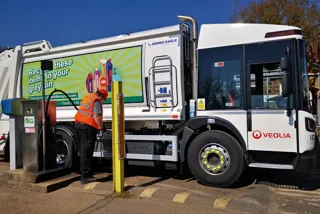The latest trials on yellow plant by Veolia have demonstrated the potential to cut carbon dioxide (CO2) by more than half (58%) across its fleet of 660-plus site-based machines.
The six-month trial has focussed on making key changes to the way vehicles are used, how they are set up for tasks, ensuring they are optimised and implementing training programmes for drivers to limit fuel use and vehicle wear.
Results of the changes were recorded by telematics across a wide range of yellow plant, including articulated haul trucks, wheel loaders, tracked vehicles, dozers and landfill compactors.
At Veolia's main main testing site in Rainham, the total time vehicles spent idling has been reduced by 50%, saving an estimated 12,000 litres of fuel a year.
Other reductions in fuel burning rates are estimated to save a further 38,000 litres of fuel a year, and together, these can save an estimated 133,000kg of carbon emissions on this site alone.
To further cut CO2 emissions, arising from the manufacture of spare parts and maintenance, the company has developed new operating regimes based on conditions for operating on site, equipment configuration, job set up, vehicle optimisation, payload, and correct loading techniques.
In combination, Veolia says that these measures make a major difference to maintenance requirements and vehicle operating life and also improve the economics of these assets.
Gary Clark, Veolia fleet director for the UK and Ireland, said: “The unprecedented carbon savings we have achieved during this trial have actively demonstrated how the industry can accelerate the transition to the net zero target, and meet our aim of ecological transformation.
“Through the hard work and engagement of our teams at all levels, supported by vehicle manufacturers, our optimisation programme has exceeded its aims.
“Together this has given us a greater understanding of the challenges and can now be extended across all of our sites to make major cuts in carbon emissions.”
Veolia will introduce its optimisation programme across its entire plant fleet, used on 83 sites, to increase CO2 savings.






















Login to comment
Comments
No comments have been made yet.